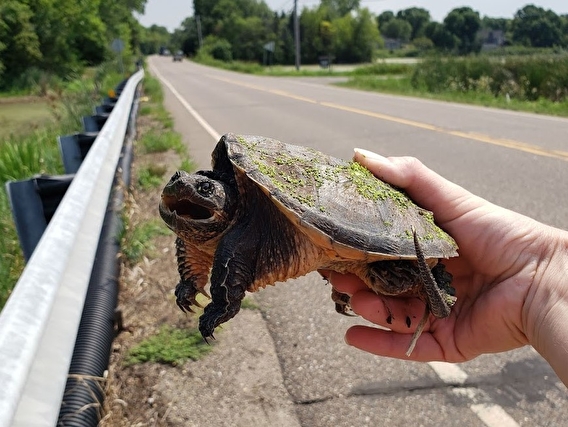
When wildlife and vehicles meet, it’s lose-lose for people and animals. Finding a solution to these conflicts is important from a conservation, fiscal, and public safety standpoint.
Environmental journalist Ben Goldfarb thinks wildlife crossings—infrastructure such as bridges or culverts—might be our best tool for keeping the peace. He shared his ideas in a March CTS webinar titled How Road Ecology Is Shaping the Future of Our Planet
Roads, Goldfarb said, are extremely harmful to animals. The FHWA estimates that around 365 million vertebrates are killed by cars on US roads every year (an underestimate, it notes), and roads often serve as barriers that disrupt habitat and isolate animals from food or breeding grounds.
“We’re hemorrhaging wildlife and biodiversity here in the US and beyond,” Goldfarb said, “and our infrastructure is an enormous part of that.”
Wildlife-vehicle crashes are also dangerous and expensive for drivers. In Minnesota, deer alone caused 1,112 crashes, 4 fatalities, and 28 serious injuries in 2020, and 2008 data from the FHWA estimates that the average deer crash costs around $4,700 in car repairs and human injury (prices have likely since climbed).
One of the best tools for mitigating these issues, Goldfarb said, is wildlife crossings. They come in a variety of forms—bridges, culverts, underpasses, and rope ladders, for example— depending on the needs of the species they accommodate, and they’re generally paired with fences to ensure that animals are funneled toward them. Worldwide, there are many success stories of crossings effectively reducing conflict between vehicles and animals.
The big drawbackis cost. Cost per crossing varies depending on the size of the structure and what animal it’s designed for. An overpass designed for large mammals (which is on the high end) might cost upwards of $5 million.
However, Goldfarb noted that even an expensive crossing can pay for itself relatively quickly; a study in Washington state, for example, documented crossings saving as much as $433,000 in crash costs per year.
“Wildlife passage and habitat connectivity is good conservation policy,” Goldfarb said, “but it’s also good fiscal policy.”
There are also ways to reduce the cost of wildlife crossings. In Minnesota, for example, researchers with the Minnesota Zoo have been using fences to funnel turtles toward already-existing culverts. Researchers at the U of M have been working to develop low-cost methods for retrofitting culverts into fish passages and modeling and mapping deer-vehicle-collision data that could be used to steer investments most effectively.
“There’s a lot we can do with the existing infrastructure that’s already on the landscape through cheap tweaks and retrofits on behalf of wildlife,” Goldfarb said.
State and federal grants can also be leveraged to pay for wildlife crossings. The 2021 Infrastructure Investment and Jobs Act allocated $350 million in grants towards the Wildlife Crossing Pilot Program and also allocated $1 billion for culvert removal, replacement, and restoration, The America the Beautiful program awards grants to projects related to restoring and improving wildlife habitat connectivity.
Goldfarb recommended gathering data and documenting instances of road-wildlife conflict to identify hotspots and prove the need for wildlife crossing funding. One good example is the Salvage Wildlife program through the U of M, which has been gathering roadkill data across Minnesota. There are also a variety of wildlife tracking websites that can be used to analyze animal movement patterns
“If we’re going to save biodiversity,” Goldfarb said, “we are going to have to truly rethink our built environment.”
The webinar, held in conjunction with a CTS Environment and Energy in Transportation Council meeting, was part of CTS's Rural Needs, Statewide Answers: Improving Transportation for All thematic focus in 2024.
—Sophie Koch, contributing writer


